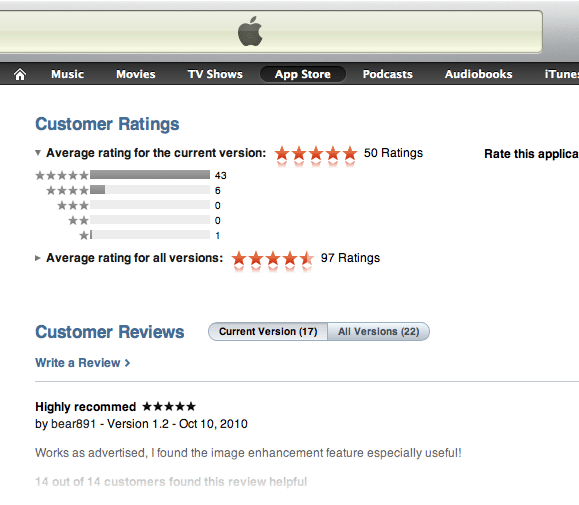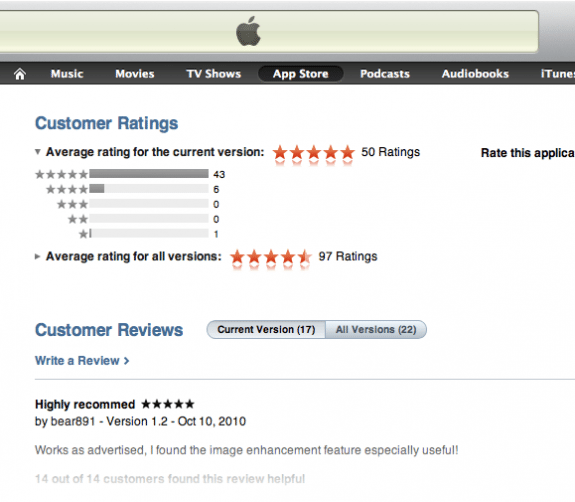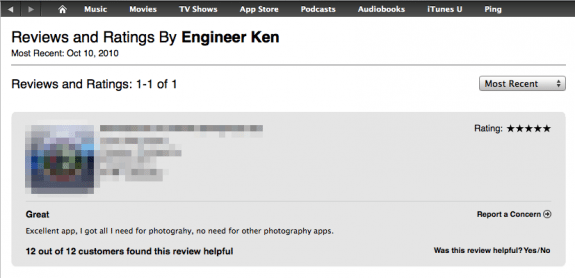UPDATED 09.01.13
As of June 2013, there are now over 300,000 900,000 apps available in the Apple App Store. With that number of apps available and new ones being released every day, it’s difficult for a developer to get exposure and chart placement for their apps. Getting an app into a category’s Top 100 in the App Store gives apps greater visibility and exposure and can mean the difference between selling thousands of copies of an app or dozens. A few unscrupulous developers resort to fake or “shill” App Store reviews in order to improve chart position and increase sales.
Nearly all of the developers in the App Store do not do this — their reviews, good or bad, are authentic. While not a widespread problem, shill reviews undermine the integrity of the user review process of the App Store. Creating fake reviews to drive up traffic increases sales and chart rankings, but it also rewards these unscrupulous developers. It also takes up chart slots that could go to honest developers who play the rules.
A lot of five star reviews and favorable written reviews can sometimes mislead an unsuspecting buyer into purchasing the app. The app often doesn’t live up to the hype of the fake reviews, but it’s only a dollar or two, right? The problem is that when an app charts — good or bad — once it breaks the Top 100 of its category, it’s probably selling hundreds or thousands of copies a day. At a dollar or two, that’s a lot of money going to a shady developer who’s selling a sub-par app. The real app store user reviews for these apps are often overshadowed by the sheer number of fake reviews and get buried.
Probably the most high profile shill review scam was the Molinker app review scam uncovered and reported by Glyn Evans and Pat Timney on The iPhoneography Blog last year. Shill review scams can get a developer booted from the App Store.
Shill reviews violate Apple’s Terms of Service, but are difficult to prove beyond a shadow of a doubt. Fortunately, with a little digging, they’re very easy for a consumer to spot.
1. A huge number of 5 star ratings — up to 50 — within hours of the app’s release. Developers are given a max of 50 promo codes for each version of an app. If you see a lot of high star ratings in a new app and very few (or none) written reviews, odds are that the developer created a bunch of fake iTunes accounts and used their allotment of promo codes to give themselves a bunch of 5 (and the occasional 4) star reviews. It’s human nature — not every user will like an app. A genuine app review should have a good distribution of 1, 2, 3, 4 and 5 star ratings. If the app is that good, the ratings will be weighted to 5 and 4 stars, but it will still have some ratings of 3, 2 and 1 stars.
UPDATE 09.01.13: When I first wrote this post in October 2010, you were able to write App Store reviews if you’d gotten the app by using a developer promo code. As reader/commenter Chris correctly states below, Apple will no longer let you do that.
One thing I have noticed, however, are commercial apps that go free for a very short period of time — often less than a few hours. In theory, this could allow those user accounts the ability to review the app. =M=
2. A large number of short, generic, non-specific reviews written in similar style and similar grammar — sometimes similar bad grammar.
3. Written reviews posted by a large number of users who have never reviewed an app before or who have only written reviews of that developer’s apps.
App review blogs, such as Life In LoFi, iPhone Photography School, and other websites are good places to find legitimate and honest app reviews. Often, we’ll call out developers who resort to these shady tactics. Again, most iPhone app developers don’t resort to shill reviews. With a little vigilance, you can avoid getting scammed by fake reviews.
=M=
~~~~
Related Links:



